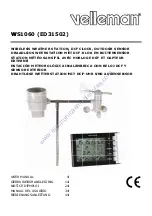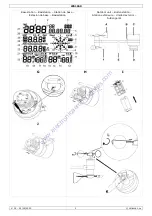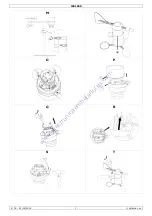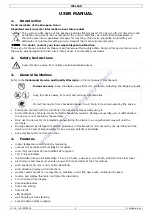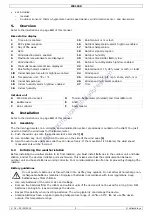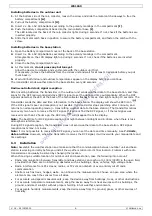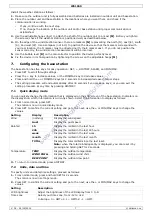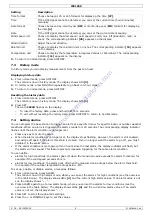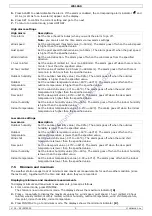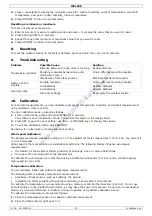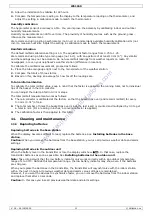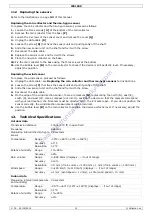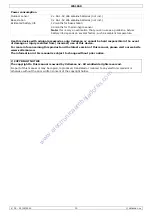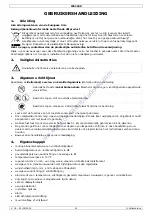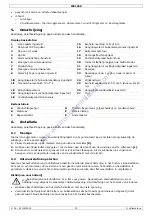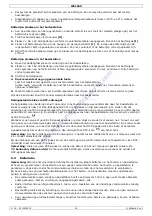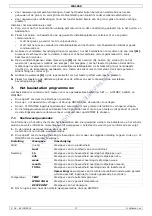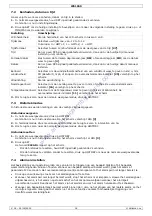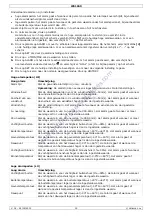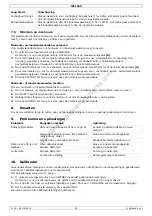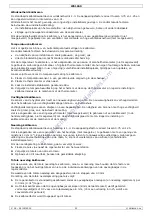
WS1060
V. 02 – 24/05/2012
6
©Velleman nv
Installing batteries in the outdoor unit
1.
At the bottom side of the rain collector, loosen the screw and slide the metal catch sideways to free the
battery compartment [G].
2.
Pull out the battery compartment [H].
3.
Insert 2 x AA 1.5V LR6 batteries according to the polarity markings in the compartment [I].
4.
Push the battery compartment back into the rain collector base [J].
The LED located at the back of the rain collector lights during 4 seconds. If not, check if the batteries are
inserted properly.
5.
Slide the metal catch back in position to secure the battery compartment, and fasten the catch with the
screw.
Installing batteries in the base station
1.
Open the battery compartment cover at the back of the base station.
2.
Insert 3 x AA 1.5V LR6 batteries according to the polarity markings in the compartment.
All segments on the LCD display light up during 2 seconds. If not, check if the batteries are inserted
properly.
3.
Close the battery compartment cover.
4.
At this moment, do not press any buttons yet.
Allow the device to initialise and synchronise with the outdoor unit first.
If necessary, remove the batteries from the indoor unit and wait for at least 10 seconds before you put
them back in.
5.
Wait until both indoor and outdoor temperatures appear on the display before you continue.
The transmitter sends weather data to the base station every 48 seconds.
Radio-controlled clock signal reception
After inserting batteries, the transmitter in the outdoor unit sends weather data to the base station, and then
scans for the DCF radio-controlled clock (RCC) signal to set the date and time automatically. When the DCF
signal is detected, the LED at the back of the rain collector flashes 5 times, then lights during 20 seconds. The
transmitter sends the date and time information to the base station. The display will show the RCC icon
.
If the DCF signal is poor and reception is not possible, the transmitter stops searching after 1 minute, and
returns to normal operating mode (= transmitting weather data to the base station). The transmitter retries
once every two hours to receive the DCF signal. If it cannot find the DCF signal, or if the last signal was
received more than 12 hours ago, the RCC icon
will disappear from the display.
Note: The best time for DCF signal reception is at night between midnight and 6:00am, when there is less
atmospheric interference.
During DCF signal reception, the transmitter does not send weather data to the base station. DCF signal
reception lasts max. 5 minutes.
Note: if it is not possible to receive the DCF signal, you can set the date and time manually. See 7.2 Units,
date and time. However, when the transmitter receives the DCF signal, it will overwrite your manual date and
time settings.
6.3
Installation
Note: Assemble the weather station and make sure that the communication between outdoor unit and base
station is working correctly before you install the weather station into its final location. Problems with radio
transmission can usually be solved by changing the location.
When choosing a suitable location for outdoor unit and base station, take the following into account:
•
Radio communication between transmitter and base station can reach up to 100m (330ft) in the open field,
provided that there are no interfering obstacles such as buildings, trees, vehicles, high voltage lines…
•
Radio interference from PC screens, radios, or TV sets can disturb or even entirely cut off radio
communication.
•
Shelters such as trees, hedges, walls… can influence the measurements. Choose an open area where the
elements can reach the sensors from all sides.
•
For accurate wind speed measurements, keep the device away from buildings, trees, or other obstructions.
•
For accurate temperature measurements, keep the device away from heat sources such as buildings, the
ground, and direct sunlight without proper shielding in hot weather environments.
•
For accurate humidity measurements, keep the device away from the ground, grass, or other sources of
humidity.
www.electronicaembajadores.com

